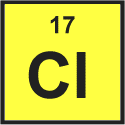Chlorine
|
Characteristics and Properties
Under standard conditions chlorine is a gas that forms diatomic molecules. This means that two chlorine atoms join together to form Cl2. Chlorine gas is greenish yellow, has a very strong odor (it smells like bleach), and is poisonous to humans. High concentrations of chlorine gas can be fatal.
Chlorine is very reactive and, as a result, is not found in its free form in nature, but only in compounds with other elements. It will dissolve in water, but will also react with water as it dissolves. Chlorine will react with all the other elements except the noble gases.
Most common chlorine compounds are called chlorides, but it also forms compounds with oxygen called chlorine oxides.
Where is chlorine found on Earth?
Chlorine can be found in abundance in both the Earth's crust and in ocean water. In the ocean, chlorine is found as part of the compound sodium chloride (NaCl), also known as table salt. In the Earth's crust, the most common minerals containing chlorine include halite (NaCl), carnallite, and sylvite (KCl).
How is chlorine used today?
Chlorine is one of the most important chemicals used by industry. Tens of billions of pounds of chlorine are produced each year in the United States alone for use in industrial applications. It is used in making a variety of products including insecticides, pharmaceuticals, cleaning products, textiles, and plastics.
You have probably heard people mention that chlorine is used in pools. Chlorine is used in pools to keep it clean and safe by killing bacteria, germs, and algae. It is also used in drinking water to kill bacteria so we don't get sick when we drink it. Because it kills germs, chlorine is also used in disinfectants and is the basis for most bleaches.
Chlorine is needed for the survival of animal life in the form of table salt (NaCl). Our body's use it to help us digest food, move our muscles, and fight off germs.
How was it discovered?
Chlorine gas was first produced by Swedish chemist Carl Wilhelm Scheele in 1774. However, for many years scientists thought that the gas contained oxygen. It was English chemist Sir Humphry Davy who proved that it was a unique element in 1810. He also gave the element its name.
Where did chlorine get its name?
Chlorine gets its name from the Greek word "chloros", which means "yellow-green."
Isotopes
Chlorine has two stable isotopes: Cl-35 and Cl-37. Chlorine found in nature is a mixture of these two isotopes.
Interesting Facts about Chlorine
- Chlorine gas was used by the Germans in WWI to poison the Allied soldiers.
- Around 1.9% of the ocean's mass is composed of chlorine atoms.
- It has a high density for a gas of 3.21 grams per liter (air is around 1.29 grams per liter).
- Chlorine is used to make chlorofluorocarbons or CFCs. CFCs were once widely used in air conditioners and spray cans. Unfortunately, they contributed to destroying the ozone layer and have been mostly banned.
- Most chlorine gas for industry is produced by using electrolysis on water that contains dissolved sodium chloride (salt water).

Комментариев нет:
Отправить комментарий